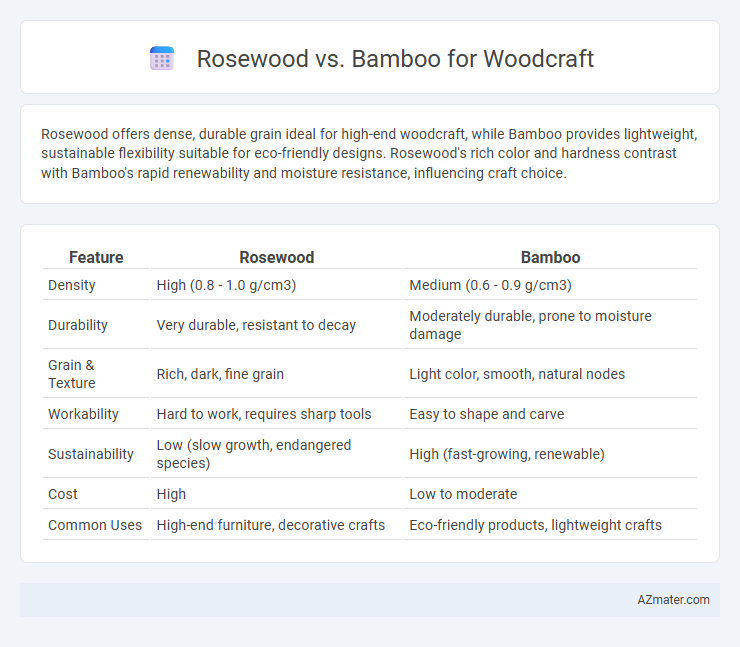Rosewood offers dense, durable grain ideal for high-end woodcraft, while Bamboo provides lightweight, sustainable flexibility suitable for eco-friendly designs. Rosewood's rich color and hardness contrast with Bamboo's rapid renewability and moisture resistance, influencing craft choice.
Table of Comparison
| Feature | Rosewood | Bamboo |
|---|---|---|
| Density | High (0.8 - 1.0 g/cm3) | Medium (0.6 - 0.9 g/cm3) |
| Durability | Very durable, resistant to decay | Moderately durable, prone to moisture damage |
| Grain & Texture | Rich, dark, fine grain | Light color, smooth, natural nodes |
| Workability | Hard to work, requires sharp tools | Easy to shape and carve |
| Sustainability | Low (slow growth, endangered species) | High (fast-growing, renewable) |
| Cost | High | Low to moderate |
| Common Uses | High-end furniture, decorative crafts | Eco-friendly products, lightweight crafts |
Introduction to Rosewood and Bamboo in Wood Craft
Rosewood and bamboo both play significant roles in wood craft, prized for their unique properties and aesthetic appeal. Rosewood is a dense, hardwood known for its rich color variations and natural durability, making it ideal for fine furniture, musical instruments, and detailed carvings. Bamboo, although technically a grass, offers exceptional flexibility, rapid renewability, and strength, favored in eco-friendly woodcraft for items like furniture, flooring, and decorative accessories.
Botanical Characteristics: Rosewood vs Bamboo
Rosewood belongs to the Dalbergia genus within the Fabaceae family, characterized by dense, oily hardwood with rich dark grain patterns and natural durability, making it ideal for fine woodworking and intricate carving. Bamboo, a member of the Poaceae family, is a fast-growing grass with hollow cylindrical stems, offering flexibility and lightweight strength, but lacks the solid density found in traditional hardwoods like rosewood. The botanical differences between rosewood's slow-growing woody structure and bamboo's rapid growth as a grass directly influence their properties and suitability in various woodcraft applications.
Sustainability and Environmental Impact
Rosewood is less sustainable due to its slow growth and overharvesting, leading to numerous species being listed under CITES protection, significantly limiting legal trade and increasing environmental impact. Bamboo offers a highly sustainable alternative, with rapid growth rates, minimal fertilizer requirements, and the ability to regenerate after harvesting without replanting, making it a renewable resource ideal for eco-friendly woodcraft. Choosing bamboo over rosewood reduces deforestation pressures, promotes biodiversity conservation, and supports sustainable manufacturing practices in the woodcraft industry.
Appearance and Grain Patterns
Rosewood showcases rich, deep hues ranging from reddish-brown to purplish tones, with dramatic dark streaks that create striking, intricate grain patterns highly sought in fine woodcraft. Bamboo offers a lighter, natural beige to pale yellow color with a uniform, linear grain that provides a clean, modern aesthetic ideal for minimalist designs. Rosewood's luxurious, complex appearance suits detailed, high-end projects, while bamboo's simplicity and consistent texture excel in sustainable and contemporary crafts.
Workability and Ease of Crafting
Rosewood offers superior workability with its dense, oily texture that allows for smooth carving and fine detailing, making it ideal for intricate wood craft projects. Bamboo, being a grass rather than a hardwood, is lightweight and flexible but requires specialized tools and techniques due to its hollow structure and tendency to splinter. Craftsmen often prefer rosewood for precision work and durability, while bamboo excels in eco-friendly designs with simpler construction processes.
Durability and Longevity
Rosewood exhibits superior durability and longevity compared to bamboo, boasting high density and natural oils that resist moisture, insects, and decay, making it ideal for intricate and long-lasting woodcraft. Bamboo, while sustainable and flexible, tends to be less dense and more prone to wear and environmental damage over time, which can reduce the lifespan of crafted items. Selecting rosewood ensures enhanced structural integrity and timeless beauty in woodcraft projects requiring robust performance.
Common Uses in Wood Craft
Rosewood is prized in woodcraft for its rich, dark hues and durability, making it ideal for high-end furniture, musical instruments, and decorative carvings. Bamboo, known for its rapid growth and sustainability, is commonly used in eco-friendly furniture, flooring, and lightweight home accessories. Both materials offer unique aesthetic qualities and functional benefits, with rosewood favored for luxury items and bamboo preferred for versatile, cost-effective projects.
Cost Comparison: Rosewood vs Bamboo
Rosewood is significantly more expensive than bamboo due to its rarity and long growth cycle, with prices often reaching several times higher per board foot. Bamboo offers a cost-effective alternative, providing rapid renewability and lower market prices while maintaining good durability for woodcraft projects. Choosing bamboo can reduce material expenses by up to 70%, making it ideal for budget-conscious artisans and large-scale production.
Maintenance and Care Requirements
Rosewood requires regular polishing and may need occasional oiling to maintain its rich luster and prevent drying or cracking, making it moderately high maintenance. Bamboo is more durable and resistant to moisture and insects, requiring less frequent care, typically just regular cleaning with a damp cloth and occasional oil treatment to maintain its sheen. Both woods benefit from avoiding prolonged exposure to direct sunlight and extreme humidity to preserve their integrity and appearance.
Choosing the Right Material for Your Project
Rosewood offers exceptional durability and rich, dark grain patterns ideal for intricate wood craft projects requiring strength and elegance, while bamboo provides a sustainable, lightweight alternative with excellent flexibility and rapid renewability. The choice depends on project needs: rosewood suits high-end, detailed pieces needing longevity, whereas bamboo excels in eco-friendly, modern designs emphasizing lightness and environmental impact. Understanding material properties like hardness (rosewood's Janka hardness ~2200 vs bamboo's ~1300) and sustainability informs the best selection for functionality and aesthetic goals.

Infographic: Rosewood vs Bamboo for Wood craft
 azmater.com
azmater.com